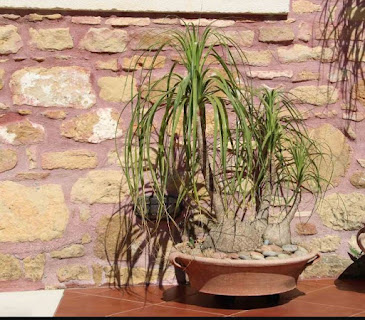Ponytail palm care: how to avoid brown leaves
Ponytail palms, also known as Beaucarnea recurvata, are unique and attractive plants that make great additions to any indoor or outdoor space.
These tropical plants, native to Mexico, feature a swollen base resembling an elephant's foot and long, slender leaves that cascade down like a ponytail.
While Ponytail palms are relatively low-maintenance, they can develop brown leaves if not what does a ponytail palm looks like In this article, we will explore the essential care tips to help you avoid brown leaves and keep your Ponytail palm thriving.
Understanding Brown Leaves in Ponytail Palms
Brown leaves in Ponytail palms can be an indication of various underlying issues. It's crucial to understand the causes and signs of unhealthy plants to address the problem effectively.
Brown leaves can result from overwatering, underwatering, inadequate light exposure, extreme temperatures, nutrient deficiencies, or pest infestations.
By recognizing the signs of brown leaves, you can take appropriate measures to restore your Ponytail palm's health.
Proper Watering Techniques
Proper watering is crucial for the health of Ponytail palms. These plants prefer infrequent but thorough watering.
Allow the soil to dry out between waterings to prevent overwatering, which can lead to root rot and brown leaves. When watering, ensure that the water penetrates the entire root ball.
It's important to use well-draining soil to prevent waterlogging and promote healthy growth.
Ideal Light Conditions
Ponytail palms thrive in bright, indirect light. They require several hours of sunlight each day to stay healthy.
However, it's essential to protect them from intense, direct sunlight, which can scorch the leaves and cause browning. Place your Ponytail palm near a window that receives bright, filtered light or provide shade during the hottest hours of the day.
Temperature and Humidity Considerations
Ponytail palms prefer warm temperatures ranging between 65°F and 85°F (18°C - 29°C). They can tolerate slightly cooler temperatures but are sensitive to frost.
Avoid exposing them to extreme temperature fluctuations, as it can stress the plant and lead to brown leaves.
Additionally, Ponytail palms appreciate moderate humidity levels. Mist the leaves occasionally to increase humidity if you live in a dry climate.
Pruning and Grooming Practices
Regular pruning and grooming can help maintain the health and appearance of your Ponytail palm. Trim brown or yellow leaves using clean, sharp shears, cutting them as close to the trunk as possible.
Remove any dead or damaged fronds to prevent disease spread and encourage new growth. Gently wipe the leaves with a damp cloth to remove dust and keep them looking vibrant.
Fertilizing and Nutrient Requirements
Fertilizing your Ponytail palm is essential to provide it with the necessary nutrients for healthy growth. Choose a balanced, slow-release fertilizer specifically formulated for palm plants.
Apply the fertilizer according to the instructions on the packaging, usually once every three to four months. Avoid overfertilization, as it can result in salt buildup and damage the roots.
Pest Control and Prevention
Ponytail palms are generally resistant to pests but can occasionally be affected by common plant insects such as spider mites or mealybugs.
Regularly inspect your plant for signs of infestation, including webbing, tiny pests, or sticky residue on the leaves. If pests are detected, use natural or chemical pest control methods to eliminate them and prevent further damage.
Potting and Repotting Guidelines
Choosing the right-sized pot and providing appropriate potting soil are crucial for the well-being of your Ponytail palm. Select a pot that allows for some room for growth but is not excessively large.
Use a well-draining potting soil mixture that retains some moisture while allowing excess water to escape. Repotting is typically required every two to three years or when the plant outgrows its current container.
Common Mistakes to Avoid
To ensure your Ponytail palm remains healthy and free from brown leaves, it's important to avoid common mistakes. Overwatering or underwatering can lead to root rot or dehydration, causing the leaves to turn brown.
Exposing the plant to extreme temperatures, especially frost, can also result in leaf damage. Neglecting pest control can lead to infestations that weaken the plant. Lastly, using incorrect potting soil that retains too much moisture can harm the roots and cause browning.
FAQS
How often should I water my Ponytail palm?
The frequency of watering depends on various factors, such as the climate and pot size. As a general guideline, water your Ponytail palm thoroughly when the top inch of soil feels dry. Be careful not to overwater or let it sit in standing water.
Why are the tips of my Ponytail palm turning brown?
Brown tips can be caused by underwatering, low humidity, or exposure to direct sunlight. Ensure you're providing adequate water and humidity levels, and protect the plant from intense sunlight.
Can I place my Ponytail palm outdoors during summer?
Yes, you can place your Ponytail palm outdoors during the summer months, but make sure it's not exposed to direct sunlight. Gradually acclimate the plant to the outdoor environment to avoid shock.
Do Ponytail palms require regular pruning?
Ponytail palms generally require minimal pruning. However, removing brown or yellow leaves and any dead or damaged fronds is recommended to maintain the plant's appearance and health.
How can I revive a dying Ponytail palm?
If your Ponytail palm is severely dehydrated or has extensive browning, it may be challenging to revive. Start by watering it properly, providing adequate light and humidity, and addressing any pest issues. If the plant doesn't show signs of recovery, it may be best to consult a plant care specialist.



Comments
Post a Comment